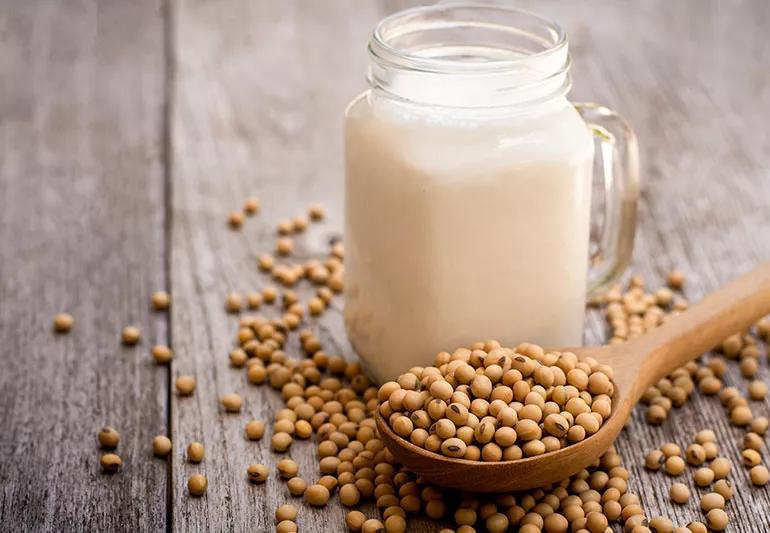A balanced diet of veggies, calcium and soy may help

Menopause comes with a lot of ups and downs. As your estrogen levels decrease, things like your body temperature and weight may increase. So, how do you stay balanced on the rollercoaster that is menopause?
Advertisement
Cleveland Clinic is a non-profit academic medical center. Advertising on our site helps support our mission. We do not endorse non-Cleveland Clinic products or services. Policy
On average, menopause happens around 51 — that means, you’ve stopped having periods for a full 12 months. But you may start to feel symptoms sooner than you expect. Perimenopause — the time period shortly before menopause — can affect women typically starting in their 40s, though it can begin as early as their mid-30s or as late as their mid-50s. During this time, you can start feeling symptoms of hot flashes, mood swings and low energy, while the decrease of estrogen can begin to affect your bones, muscle mass and metabolism.
Luckily, the foods you eat may make a significant difference. Women’s health specialist Lynn Pattimakiel, MD, explains what foods to try (or avoid) to help alleviate symptoms and changes from menopause.
Having a well-balanced diet is crucial during any stage of life, but during menopause, your body needs some extra patience and care. From changes in metabolism to increased risk of osteoporosis, shifting your diet can help with getting ahead of future symptoms. This is why Dr. Pattimakiel recommends incorporating a variety of vegetables, protein and calcium into your diet. Not sure where to start? The Mediterranean diet is recommended as a good all-in-one meal plan that focuses on lean proteins, whole grains and plenty of plant-based foods.
Advertisement
At the same time, Dr. Pattimakiel stresses that it’s important not to push your body too hard with any extreme diets. Instead, find something that fits your lifestyle and includes what you enjoy eating.
“We want to be realistic about what is sustainable long term,” says Dr. Pattimakiel. “So, we want to make changes that you can make now and continue going forward.”
Here are some foods to incorporate into your diet and how they can help:
While you’re dealing with hot flashes and night sweats, your bones are going through changes of their own throughout menopause. This may not be something you feel right away, but bone loss becomes more prevalent during this time and can even lead to conditions like osteoporosis.
“Your body is building bone up until age 30. After that, you start to lose bone,” explains Dr. Pattimakiel. “Since you’re losing that estrogen around menopause, there’s an accelerated decline of that bone.”
That’s why Dr. Pattimakiel stresses the importance of looking for more calcium-rich foods to help keep your bones strong and healthy.
Try foods with high sources of calcium like:
You’re aiming for about 1,200 milligrams–1,500 milligrams a day to ensure your calcium is at a good level. Not a huge milk drinker or are you completely dairy-free? No problem. You can always break this up throughout your day by having a portion of oatmeal (150 milligrams) and orange juice concentrate (300 milligrams) for breakfast (150 milligrams), some leafy vegetables at lunch (300 milligrams) and maybe some seasoned tofu for dinner (120milligrams–390 milligrams).
Moving onto your veggie drawer, you’re not going to want to skimp out on those healthy greens either.
“Half of your plate should have green leafy vegetables so you’re getting all of that nutritional value,” Dr. Pattimakiel notes.
Not only do leafy vegetables help with managing weight, but they can also help with bone health. Veggies like spinach, turnips and collard greens are great sources of calcium.
Other veggies to work into your diet that help you maintain a healthy weight and reduce the severity of hot flashes include:
In the protein department, you’ll want to focus on leaner meats and proteins to keep your menopause symptoms as happy as possible. This switch can help with weight management, but it also ensures you’re increasing bone strength and muscle mass.
Some lean protein to work into your diet:
“You can have red meat once in a while, but we have to be careful with cholesterol as well,” Dr. Pattimakiel adds.
The soy products in your pantry and fridge may now do double duty. It’s been shown that soy-based products can help with relieving certain menopausal symptoms. In fact, Dr. Pattimakiel recommends trying soy products in the form of food over soy supplements.
Advertisement
“Soy from food products may alleviate hot flashes and night sweats in some women,” says Dr. Pattimakiel.
According to some studies, soy products may help ease menopausal symptoms because they contain phytoestrogens — a chemical that’s similar to estrogen. But it can be a hit or miss for some. Not everyone carries the certain enzyme that converts the soy from phytoestrogen into estrogen.
Some soy-based products include:
Of course, tweaking your diet can be tricky if you deal with any dietary restrictions. You can also consider taking certain supplements to help fill any nutritional gaps your body needs. But be sure to talk to your healthcare provider before beginning any new supplements.
It’s true, you don’t need to rely on dairy products to get your daily calcium intake. Especially if you’re lactose intolerant, have dairy sensitivity or are vegan, reaching for a yogurt every morning may not be an option. Luckily, taking over-the-counter calcium pills can do the trick. Just make sure you’re not taking excessive calcium supplementation. Also, be sure to divide the dose, because your gut can only absorb 500 milligrams of calcium at one time.
Even if your diet includes plenty of calcium, don’t skip that daily vitamin D pill. “Vitamin D is absolutely necessary to help absorb the calcium intake,” says Dr. Pattimakiel. “They’re both needed to help improve the structure of the bone.”
Advertisement
Especially as a lot of us don’t get enough of this essential vitamin from sun exposure, you may need a boost anyway. This can range from person to person though, so be sure to ask your healthcare provider whether or not you should get your levels checked.
Black cohosh is a herb native to North America that’s known to help with estrogen-related conditions. In some cases, it’s been shown to actually increase estrogen in the body and even relieve symptoms like night sweats and hot flashes.
You can take black cohosh capsules with a glass of water. But it isn’t recommended to be taken for long periods of time without consulting your healthcare provider.
"They only recommend it for up to six months at a time,” cautions Dr. Pattimakiel.
This supplement isn’t FDA-approved, either.
If you’ve been searching for natural remedies to ease menopause symptoms, it’s likely you’ve run across the mention of wild yam. A quick search will turn up plenty of available extracts and tinctures, but research shows wild yam extract — though while not harmful — has little effect on menopause symptoms.
This may be because the popular Thanksgiving tuber vegetable has something called diosgenin, which may have positive effects on estrogen in your body. You can still try it, but just know we’re still learning more about the pros and cons of supplements such as this one.
Advertisement
When going through menopause, what you cut out can have as much of an impact as what you’re adding in. First up: Listen to your body. If you’re noticing certain foods are triggering your symptoms, try taking them out (or replacing them) to see if there’s a difference. But there are also a couple of general foods you may want to take a break from.
Here are some common foods that you should avoid:
Especially if you’re experiencing hot flashes and night sweats, you may want to cut back on the hot sauce. Unsurprisingly, spicy foods can bring your body temperature up, trigger these symptoms or make them worse.
Try avoiding foods like cayenne pepper, hot salsa and jalapeno peppers to keep your body cool as a cucumber. If you still want to add a kick of flavor to your meals, try using herbs like thyme or basil.
As much as you love your morning cup of joe, caffeine may be partially to blame for your menopausal hot flashes. While this doesn’t mean you have to cut it out completely, excess caffeine has been shown to make those heat waves more severe.
Same goes for alcohol. If you’re experiencing intense hot flashes, night sweats, trouble sleeping or the number on the scale is creeping up, try cutting out that glass of wine in the evening to see if your symptoms improve.
Pasta may be your comfort food, but your body may process those carbs differently throughout menopause. Because your metabolism slows down, it can lead to accelerated weight gain for some. This is why certain foods may be behind some of those extra pounds.
“There’s never any magic solution, but starchy carbs tend to be the biggest culprit,” says Dr. Pattimakiel. “During menopause, it’s much harder for your body to process these foods because it just gets converted to sugar in the body.”
If menopause is causing unwanted weight gain, you can try cutting foods like:
The same goes for processed foods and sugars. Basically, if your body always had trouble processing these types of foods, your menopause will make it even more difficult.
All in all, we know that menopausal changes can throw you for a loop. But keeping your diet balanced (and still tasty) is a great way to try and relieve symptoms. Whether it be hot flashes or bone health, what you put on your plate can make a difference. Be sure to talk to your healthcare provider or dietitian before trying any new diets or supplements.
Learn more about our editorial process.
Advertisement

The choices you make at mealtime could reduce hot flashes or make them worse

If you’ve noticed changes in your mood and mental health while going through menopause, you’re not alone

Missed periods, heavy periods, painful sex and frequent hot flashes are just a few symptoms worth discussing with your provider

At-home tests measure FSH levels in urine, but they can’t actually diagnose menopause

You may be more prone to hot flashes if you have anxiety, but hot flashes can also rev up anxiety

Heat starts in your chest and moves up to your neck and face … and then, the sweating begins

While they may not burn calories or cause fevers, these heat waves can make you miserable — but you don’t have to just grin and bear it!

It’s a natural part of aging, starting with perimenopause and eventually leading into postmenopause

If you’re feeling short of breath, sleep can be tough — propping yourself up or sleeping on your side may help

If you fear the unknown or find yourself needing reassurance often, you may identify with this attachment style

If you’re looking to boost your gut health, it’s better to get fiber from whole foods